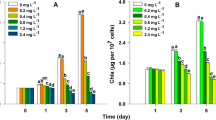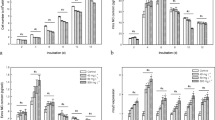Abstract
Wheat bran leachate (WBL) has been shown to have an inhibitory effect on Microcystis aeruginosa in this study. In order to explore the inhibitory mechanism of WBL on M. aeruginosa, physiological responses of M. aeruginosa NIES-843 under the WBL stress were studied. The expressions of six important genes related to the D1 protein of photosynthetic processes (psbA), synthesis of microcystins (mcyB), antioxidant protein peroxiredoxin (prx), synthesis of fatty acid (fabZ) and the repair of biological macromolecules (recA, grpE) were studied. Under the WBL stress, no significant change was found in expressions of both grpE and recA, but expressions of psbA, fabZ and prx were shown to be down-regulated, and slight up-regulated expression was found in mcyB. It was shown that oxygen evolution of M. aeruginosa NIES-843 was significantly depressed, and intracellular ATP contents became lower, after exposure to WBL. Similarly, maximum electron transport rates of photosynthetic activities decreased significantly, but intracellular reactive oxygen species levels boosted dramatically under the WBL stress, and cell lysis was observed. Therefore, it is suggested that photosynthetic systems and membranes were the potential targets of toxicity of WBL on M. aeruginosa, and the oxidative damage is an important mechanism explaining the inhibitory effect of WBL on M. aeruginosa.







Similar content being viewed by others
References
Ball AS, Williams M, Vincen D et al (2001) Algal growth control by a barley straw extract. Bioresour Technol 77:177–181
Barrett PRF, Littlejohn JW, Curnow J (1999) Long-term algal control in a reservoir using barley straw. Hydrobiologia 415:309–313
Bustin SA (2000) Absolute quantification of mRNA using Real-Time reverse transcription polymerase chain reaction assays. J Mol Endocrinol 25:169–193
Carmichael WW (1995) Toxic Microcystis in the environment. In: Watanabe MF, Harada K, Carmichael WW, Fujiki H (eds) Toxic Microcystis. CRC Press, New York, pp 1–12
Everall NC, Lee DR (1996) The use of barley-straw to control general and blue-green algal growth in a Derbyshire reservoir. Water Res 30:269–276
Ferrier MD, Butler BRS, Terlizzi DE, Lacouture RV (2005) The effects of barley straw (Hordeum vulgare) on the growth of freshwater algae. Bioresour Technol 96:1788–1795
Floyd RA (1990) Role of oxygen free radicals in carcinogenesis and brain ischemia. FASEB 4:2587–2597
Gibson MT, Welch IM, Barrett PRF et al (1990) Barley straw as an inhibitor of algal growth II: laboratory studies. J Appl Phycol 2:241–248
Hong Y, Hu HY, Li FM (2008) Physiological and biochemical effects of allelochemical ethyl 2-methyl acetoacetate (EMA) on cyanobacterium Microcystis aeruginosa. Ecotoxicol Environ Safe 71:527–534
Ichimura T (1979) Media for freshwater cyanobacteria. In: Nishizawa K, Chihara M (eds) Methods in phycology. Kyouritsu Shuppan, Tokyo, pp 295–296
Jang MH, Joo HK, Takamura GJ (2003) Toxin production of cyanobacteria is increased by exposure to zooplankton. Freshw Biol 48:1540–1550
Kaebernick M, Neilan BA, Börner T et al (2000) Light and the transcriptional response of the microcystin biosynthesis gene cluster. Appl Environ Microbiol 66:3387–3392
Kim HK, Kim SJ, Lee JW et al (1996) Identification of promoter in the 50-flanking region of the E. coli thioredoxin-liked thiol peroxidase gene: evidence for the existence of oxygen-related transcriptional regulatory protein. Biochem Biophys Res Commun 221:641–646
Kim YS, Min J, Hong HN et al (2007) Gene expression analysis and classification of mode of toxicity of polycyclic aromatic hydrocarbons (PAHs) in Escherichia coli. Chemosphere 66:1243–1248
Kurmayer R, Kutzenberger T (2003) Application of real-time PCR for quantification of microcystin genotypes in a population of the toxic cyanobacterium Microcystis sp. Appl Environ Microbiol 69:6723–6730
Latifi A, Ruiz M, Jeanjean R et al (2007) PrxQ-A, a member of the peroxiredoxin Q family, plays a major role in defense against oxidative stress in the cyanobacterium Anabaena sp. strain PCC7120. Free Radic Bio Med 42:424–431
Lee SJ, Jang MH, Kim HS et al (2000) Variation of microcystin content of Microcystis aeruginosa relative to medium N:P ratio and growth stage. J Appl Microbiol 89:323–329
Nishiyama Y, Allakhverdiev SI, Murata N (2005) Inhibition of the repair of Photosystem II by oxidative stress in cyanobacteria. Photosynth Res 84:1–7
Nishiyama Y, Allakhverdiev SI, Murata N (2006) A new paradigm for the action of reactive oxygen species in the photoinhibition of photosystem II. Biochim Biophys Acta 1757:742–749
Nübel U, Garcia-Pichel F, Muyzer G (1997) PCR primers to amplify 16S rRNA genes from cyanobacteria. Appl Environ Microbiol 63:3327–3332
Oh HM, Seog JL, Jang MH, Yoon BD (2000) Microcystin production by Microcystis aeruginosa in a phosphorus-limited chemostat. Appl Environ Microbiol 66:176–179
Pape HL, Solano-Serena F, Contini P et al (2004) Involvement of reactive oxygen species in the bactericidal activity of activated carbon fibre supporting silver bactericidal activity of ACF(Ag) mediated by ROS. J Inorg Biochem 98:1054–1060
Park MH, Han MS, Ahn CY et al (2006) Growth inhibition of bloom-forming cyanobacterium Microcystis aeruginosa by rice straw extract. Lett Appl Microbiol 43:307–312
Park MH, Chung IM, Ahmad A et al (2009) Growth inhibition of unicellular and colonial Microcystis strains (Cyanophyceae) by compounds isolated from rice (Oryza sativa) hulls. Aquat Bot 90:309–314
Pavel PK, Daniel RC (2002) Over 1000 genes are involved in the DNA damage response of Escherichia coli. Mol Microbiol 44:89–105
Pillinger JM, Cooper JA, Ridge I (1994) Role of phenolic compounds in the antialgal activity of barley straw. J Chem Ecol 20:1557–1569
Pillinger JM, Gilmour I, Ridge I (1995) Comparison of antialgal activity of brown-rotted and white-rotted wood and in situ analysis of lignin. J Chem Ecol 8:1113–1125
Pillinger JM, Cooper JA, Harding CJ (1996) Stable free radical from plant litter decomposing in water. J Chem Ecol 22:1001–1011
Richards FA, Thompson TG (1952) The estimation and characterization of plankton populations by pigment analyses. II. A spectrophotometric method for the estimation of plankton pigments. J Marine Res 11:156–172
Ridge I, Pillinger IM (1996) Towards understanding the nature of algal inhibitors from barley straw. Hydrobiologia 340:301–305
Ridge I, Pillinger JM, Walters J (1995) Alleviating the problems of excessive algal growth. In: Harper DM, Ferguson AJD (eds) The ecological basis for river management. J. Wiley & Sons, Chichester, pp 211–218
Robert JM, Gu MB (2004) Construction and characterization of novel dual stress-responsive bacterial biosensors. Biosens Bioelectron 19:977–985
Schatz D, Keren Y, Vardi A, Sukenik A et al (2007) Towards clarification of the biological role of microcystins, a family of cyanobacterial toxins. Environ Microbiol 9:965–970
Shao JH, Wu ZX, Yu GL et al (2009) Allelopathic mechanism of pyrogallol to Microcystis aeruginosa PCC7806 (Cyanobacteria): from views of gene expression and antioxidant system. Chemosphere 75:924–928
Stork T, Michel KP, Pistorius E et al (2005) Bioinformatic analysis of the genomes of the cyanobacteria Synechocystis sp. PCC 6803 and Synechococcus elongatus PCC 7942 for the presence of peroxiredoxins and their transcript regulation under stress. J Exp Bot 422:3193–3206
Swarnamukhi PL, Sharma SK, Bajaj P et al (2006) Crystal structure of dimeric FabZ of Plasmodium falciparum reveals conformational switching to active hexamers by peptide flips. FEBS Lett 580:2653–2660
Urbach E, Robertsin D, Chisholm S (1992) Multiple evolutionary origins of prochlorophytes within the cyanobacterial radiation. Nature 355:267–270
Winter J, Link K, Jatzek A (2005) Severe oxidative stress causes inactivation of DnaK and activation of the redox-regulated chaperone Hsp33. Mol Cell 17:381–392
Wood ZA, Schroder E, Robin HJ et al (2003) Structure, mechanism and regulation of peroxiredoxins. Trends Biochem Sci 28:32–40
Acknowledgements
The present research is supported the National Natural Science Foundation of China (NSFC) (30821140542), the National Water Science and Technology Projects (2009ZX07101-013-02) and (2008ZX07105-006), and the Talent Scientist Program of the Chinese Academy of Sciences (082303-1-501).
Author information
Authors and Affiliations
Corresponding author
Rights and permissions
About this article
Cite this article
Shao, J., Yu, G., Wang, Z. et al. Towards clarification of the inhibitory mechanism of wheat bran leachate on Microcystis aeruginosa NIES-843 (cyanobacteria): physiological responses. Ecotoxicology 19, 1634–1641 (2010). https://doi.org/10.1007/s10646-010-0549-1
Accepted:
Published:
Issue Date:
DOI: https://doi.org/10.1007/s10646-010-0549-1




